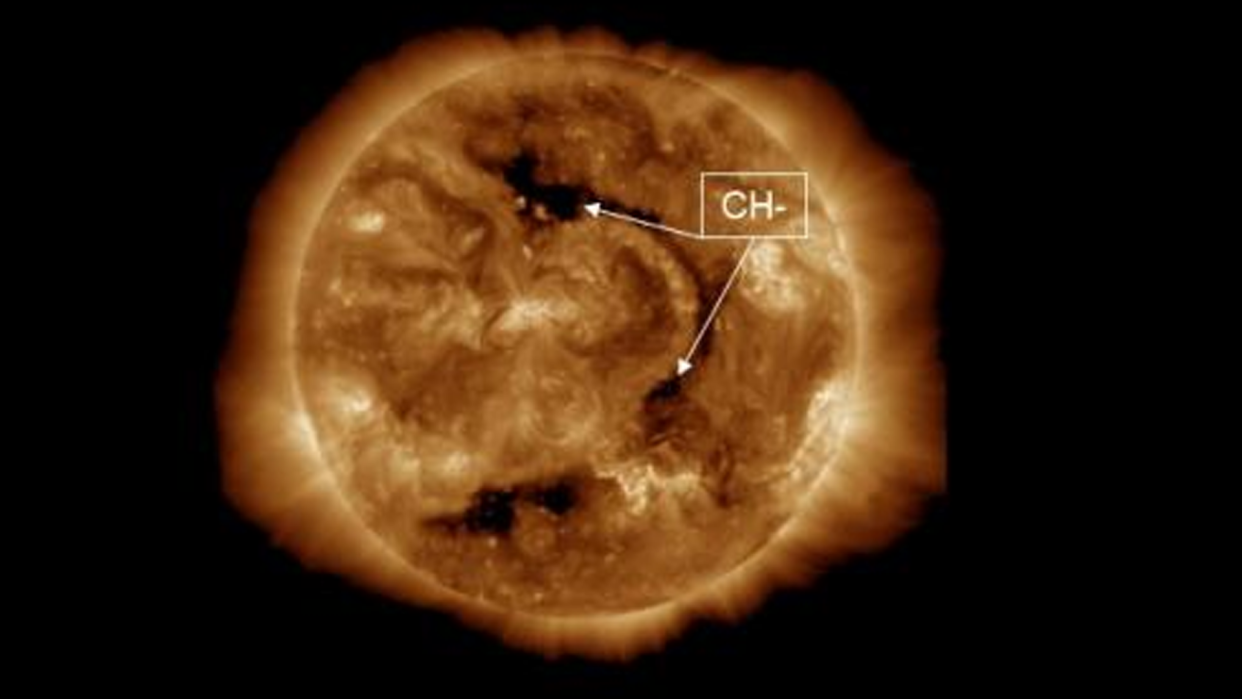Holes in sun's atmosphere can help predict space weather on Earth

Coronal holes are cooler, darker regions in the sun's upper atmosphere, the corona, from which solar wind streams into space at high speed. A new study has now found that the magnetic properties of these holes can be used to forecast the severity of geomagnetic storms that hit Earth.
Geomagnetic storms happen when bursts of solar wind, streams of magnetized particles from the corona, interact with Earth's magnetic field and penetrate the planet's atmosphere. Some geomagnetic storms are a result of coronal mass ejections (CMEs), powerful eruptions of plasma from the corona that usually originate from sunspots.
Sunspots, like coronal holes, are darker and cooler than the rest of the sun's disk, but they form in the lower layer of the sun's atmosphere, the photosphere. Unlike coronal holes, sunspots are areas where the sun's magnetic field is extremely strong and the magnetic lines twisted. At some point, the convoluted magnetic lines burst, releasing a flash of light in the form of a solar flare and a CME. Coronal holes, on the contrary, feature magnetic lines that are open, not looping back to the sun, allowing solar wind to flow freely into space.
The new study found that the solar wind flowing from the coronal holes maintains its magnetic polarity in 80% of cases throughout its journey in space. Knowing this polarity is key for predicting whether and how much the burst of the solar wind will destabilize Earth's magnetosphere.
Related: Huge solar flare erupts on the sun from 'hyperactive' sunspot
If the magnetic fields of Earth and the one carried by the solar wind meet with the same poles, they will repel each other and have very little effect on the planet. If those fields, however, meet through their opposing poles, they will connect and allow the charged particles of the solar wind to penetrate deep into Earth's atmosphere. As these solar wind particles interact with the air around the planet, they trigger beautiful aurora displays that spread around the poles.
These magnetic interplays, however, also have many unwanted side effects. In extreme cases, they can cause power blackouts on Earth, damage orbiting satellites or even cause them to fall from orbit.
Currently, space weather forecasters have to wait for the solar wind to reach NASA's SOHO satellite to learn about the magnetic properties of the solar wind. SOHO orbits the sun in sync with Earth, positioned in the so-called Lagrange Point 1 (L1) 900,000 miles (1.5 million kilometers) away from Earth toward the sun. It takes several days for the burst of solar wind to reach SOHO. But it only takes a few hours for it to then arrive at Earth.
The new forecasting method, developed by a team of researchers from the Skolkovo Institute of Science and Technology in Russia, the University of Graz in Austria, the Leibniz Institute for Astrophysics in Germany and the University of Zagreb in Croatia could increase these warning times from hours to days for the type of solar wind bursts coming from coronal holes.
Related stories:
— NASA's solar forecast is turning out to be wrong. This team's model is still on track.
— Extreme solar storms can strike out of the blue. Are we really prepared?
— Satellites can disappear in major solar storms and it could take weeks to find them
"We showed that the magnetic field from a coronal hole propagating from the sun to Earth is preserved in more than 80% of the cases," Simona Nitti, a Skolkovo science graduate and lead author of the study, said in an emailed statement. "This opens a possibility to use the magnetic field derived from solar observations instead of that at L1."
A single coronal hole can cause quite a lot of trouble. As the sun rotates, an old coronal hole can reappear after 27 days. Some coronal holes in the past managed to survive for up to six months, spewing solar wind at Earth during every single pass across the sun's visible disk.
The study was published on Jan. 5 in the journal Monthly Notices of the Royal Astronomical Society.
Follow Tereza Pultarova on Twitter @TerezaPultarova. Follow us on Twitter @Spacedotcom and on Facebook.

